Editor’s note: Every other
month, HerbalEGram highlights a conventional food and briefly explores its
history, traditional uses, nutritional profile, and modern medical research. We
also feature a nutritious recipe for an easy-to-prepare dish with each article
to encourage readers to experience the extensive benefits of these whole foods.
With this series, we hope our readers will gain a new appreciation for the foods
they see at the supermarket and frequently include in their diets. We would like to
acknowledge ABC Chief Science Officer Stefan Gafner, PhD, and HerbalGram Associate Editor Hannah Bauman for their contributions to
this project.
By Jenny Perez, ABC Education Coordinator
Overview
The cashew (Anacardium occidentale) belongs to the
sumac family (Anacardiaceae), a tropical and subtropical plant family known for
caustic resins that can cause allergic reactions. Members of this plant family,
including poison ivy (Toxicodendron
radicans) and poison sumac (T.
vernix), have resin ducts in the bark which exude gums and resins that
become black when exposed to air.1 In addition to the cashew plant, other
economically important fruits and nuts in the sumac family include mango (Mangifera indica), sumac berry (Rhus spp.) and pistachio (Pistacia
vera).1
The cashew is an
evergreen tree with an irregularly shaped trunk and twisted, crooked branches that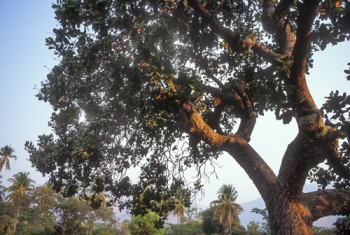 can grow to a height of 40 feet.2-4 Cashew trees can thrive in the tropical
climates of Central and South America, where soils are thin and humidity is
high.2,3 Its leathery leaves have smooth margins and are two to
eight inches long, up to six inches wide, elliptical in shape, and spirally
arranged around the stem.2,3 The tree produces 10-inch long panicles
(multi-branched infloresences) of seven-petaled, small fragrant flowers that
change from pale green to a coppery-pink color after pollination has occured.3,4
The true fruit of the tree is the one-inch-long, kidney-shaped, nut-like fruit,
commercially known as the cashew nut.3,5
can grow to a height of 40 feet.2-4 Cashew trees can thrive in the tropical
climates of Central and South America, where soils are thin and humidity is
high.2,3 Its leathery leaves have smooth margins and are two to
eight inches long, up to six inches wide, elliptical in shape, and spirally
arranged around the stem.2,3 The tree produces 10-inch long panicles
(multi-branched infloresences) of seven-petaled, small fragrant flowers that
change from pale green to a coppery-pink color after pollination has occured.3,4
The true fruit of the tree is the one-inch-long, kidney-shaped, nut-like fruit,
commercially known as the cashew nut.3,5
The cashew “apple,”
which more closely resembles a pear (Pyrus spp., Rosaceae) in shape, is
an accessory fruit, or false fruit (pseudofruit), that develops from the
receptacle of the flower rather than the flower itself.3,4 It is reddish
or yellow in color and grows up to four inches — three times the size of the cashew
nut, or true fruit. 2,3 The true fruit of the cashew tree is a drupe
that grows at the end of the pseudofruit and consists of two walls or shells. The
outer shell is smooth, thin, and elastic, and changes in color from olive green
to pale brown when ripe.2,3 Within the drupe is a single seed: the
cashew nut.3 The seed is surrounded by a double shell containing a
mixture of anacardic acids, which are closely related to urushiol (the caustic oily
mixture exuded by poison ivy).3
Historical and Commercial Uses
The cashew tree is
called maranon in most
Spanish-speaking countries, but known as merey
in Venezuela.5 In northeastern Brazil, the cashew tree is regionally
known as cajueiro and the fruit is
called caju, which is derived from what indigenous
peoples called acaju or acajous (“to pucker the mouth”), referring to the astringent flavor
of the fruit.3,4 During the late 16th century, Portuguese traders
brought the cashew plant to eastern Africa and India, where it thrived in nutrient-deficient
sandy soils and was used as a fast-growing soil retainer near the seacoast.2,4,5
Once naturalized, cashew trees were extremely hardy and drought tolerant,
living 30 to 40 years in the extreme tropical heat of these regions.4-6
When the low-growing, gnarled branches of the cashew tree rest upon the ground,
they take root and can form extensive forests in the tropical lowlands of
northern South America, Central America and the West Indies.4,5
Cashe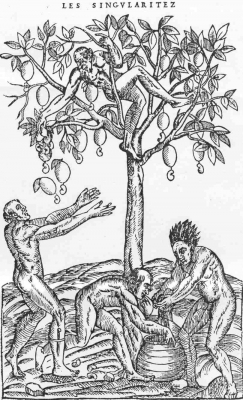 w trees are
economically important, and their components have numerous uses. The wood from
cashew trees can be used for shipping crates, boats, and charcoal.5
The rough bark contains resin, acrid sap, and a gum similar to gum arabic (Senegalia senegal, Fabaceae).4,5
Untreated wood from the cashew tree may cause allergic reactions and must be
handled with care by susceptible individuals.2 Resins from the unprocessed
cashew seed are commercially known as cashew nut seed liquid (CNSL) and are considered
an important agricultural byproduct of cashew production.3 CNSL is used
as an insecticide, wood varnish, industrial sealant, laminating resin, epoxy
resin, rubber compounding resin, and in cashew cement and other industrial
applications.2,3 The caustic, acrid-tasting resin present between
the inner and outer cashew shell is used topically as a traditional medicine to
remove corns and warts.5 w trees are
economically important, and their components have numerous uses. The wood from
cashew trees can be used for shipping crates, boats, and charcoal.5
The rough bark contains resin, acrid sap, and a gum similar to gum arabic (Senegalia senegal, Fabaceae).4,5
Untreated wood from the cashew tree may cause allergic reactions and must be
handled with care by susceptible individuals.2 Resins from the unprocessed
cashew seed are commercially known as cashew nut seed liquid (CNSL) and are considered
an important agricultural byproduct of cashew production.3 CNSL is used
as an insecticide, wood varnish, industrial sealant, laminating resin, epoxy
resin, rubber compounding resin, and in cashew cement and other industrial
applications.2,3 The caustic, acrid-tasting resin present between
the inner and outer cashew shell is used topically as a traditional medicine to
remove corns and warts.5
In the international
tree nut trade, cashew ranks third in global sales, with more than 20% of the
market, and it is considered the second-most-expensive nut traded in the United
Sates, after macadamia (Macadamia spp., Proteaceae) nuts.6,7 Cashew
processing and exportation began in the 1950s in India, and consumer demand has
steadily increased.6 Cashews are produced in 32 countries with
tropical and subtropical climates. According to published Food and Agriculture
Organization (FAO) data, in 2005, the three major cashew-producing countries were
India, Brazil, and Indonesia, followed by Vietnam and Nigeria.2,3,5 Global
annual production was reported to be 2.7 million tons.3
Cashew nut kernels
are not true nuts and must be carefully processed before consuming. Processing
involves several labor-intensive steps and must be undertaken with care due to the
brown, oily resin composed mainly of anacardic acids in the nut shell that can
blister human skin.2,6 First, the nuts are removed from the cashew
apple and then baked to loosen the inner and outer shells. This process often
takes place in a roasting cylinder to avoid exposure to and inhalation of the
caustic fumes caused by the burning resin. The shells are then removed by hand to
harvest the edible seed inside.2,3,7 Processing cashew nuts is
somewhat hazardous, and workers must wear gloves to avoid painful skin rashes.3,6
The thin,
reddish-brown seed coat of the cashew, which contains 25% tannins, is difficult
to remove, causes astringent, tingling sensations in the mouth, and generally is
not desired by consumers.6,7 Cashews that are whole, white, and without
a seed coat (sold as “raw”) are considered high quality.6 Unfortunately,
the removal of the seed coat also removes potent antioxidants, catechin and
epicatechin, which are only present in the seed coat.7 More recent
cashew-processing techniques enable the removal of the caustic CNSL while leaving
the cashew skins intact, which increases levels of phenolic compounds compared
to skinless cashew products.6
Cashew nuts are rich
in oils and versatile in use, providing a distinct flavor in numerous chicken
and vegetarian dishes of southern India and Asia. In Chinese cooking, cashews
are often added to stir fries.4 In Western countries, cashews are
consumed as a protein-rich snack food.2 Cashew nuts can be easily
ground into a spread similar to peanut (Arachis hypogaea, Fabaceae) butter.2,4
The fragile cashew
apple must be hand-picked and the curved fruits detached before being
sun-dried.2 Due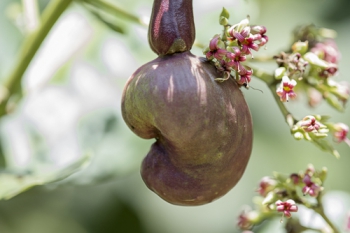 to the hazards of processing the cashew nut, Latin
Americans and West Indians commonly discard the nut and enjoy the juicy cashew
apple instead. Cashew apples are highly perishable due to their susceptibility
to various yeast and fungi post-harvest.3,5 The juicy, acidic pulp of
cashew apples is consumed fresh or used in beverages, jellies, and chutneys.2
Cashew apple juice is very astringent and contains over 30% tannins.5
In Cuba and Brazil, cashew apple juice was prescribed as a remedy for sore
throats and chronic dysentery.5 to the hazards of processing the cashew nut, Latin
Americans and West Indians commonly discard the nut and enjoy the juicy cashew
apple instead. Cashew apples are highly perishable due to their susceptibility
to various yeast and fungi post-harvest.3,5 The juicy, acidic pulp of
cashew apples is consumed fresh or used in beverages, jellies, and chutneys.2
Cashew apple juice is very astringent and contains over 30% tannins.5
In Cuba and Brazil, cashew apple juice was prescribed as a remedy for sore
throats and chronic dysentery.5
In Brazil, the pulp
is fermented to make a vinegar called anacard,
the juice is consumed diluted and sweetened as a refreshing beverage known as cajuina, distilled into liquor, or
fermented into a Madeira-like wine known as cajuada.3,4
Similarly, in Goa, India, the juicy pulp of the cashew apple is used to prepare
fenny, a regionally popular distilled liquor. In Nicaragua, cashew apples are
consumed fresh, made into juice, and used to create sweets, jellies, wine, and
vinegar.5 Despite the versatility of the cashew apple, in many parts
of the world, the cashew apple is discarded after the nut is removed because of
its short shelf life.3
Nutrients and Phytochemicals
Nuts can help manage
blood cholesterol levels, which is an important component of cardiovascular
health.8 Cashew nut kernels are nutrient and calorie dense. They
contain protein, cholesterol, more carbohydrates than other nuts (with the
exception of pistachios), and are high in fat, most of which is unsaturated.4
Its high energy and protein content are ideal for growing children, pregnant
and nursing mothers, and those recovering from illness.7
Cashews, along with almonds
(Prunus dulcis, Rosaceae) and pistachios, have the highest protein of
all tree nuts.6 The predominant amino acid is arginine, which plays
a role in the vasodilation of blood vessels.6 Despite cashew nut’s
high protein content, its biological value (BV), or protein bioavailability, is
low due to the limited content of essential amino acids, especially lysine.6
Since essential amino acids represent the bottleneck in protein production in
the human body, protein sources with low quantities of essential amino acids
have a lower BV.
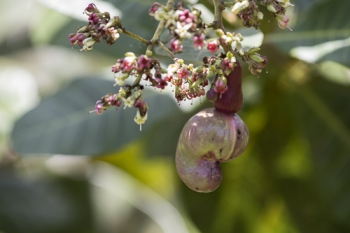 The most abundant
vitamin in cashew nuts is vitamin E (α- and γ-tocopherols), which protects unsaturated
fatty acids from becoming damaged through oxidation.6,8 Cashews
contain one of the highest levels of vitamin K of all nuts, an important
vitamin for bone health and immunity.6 Like most nuts, cashews are rich
in minerals, including potassium, magnesium, and calcium, all of which are important
for maintaining bone health, heart health, and many other important body
functions.7 Levels of phosphorus, potassium, and magnesium are high
enough to substantiate US Food and Drug Administration (FDA)-approved nutrition
label claims.6 Cashew nuts also contain copper, iron, and zinc.7 The most abundant
vitamin in cashew nuts is vitamin E (α- and γ-tocopherols), which protects unsaturated
fatty acids from becoming damaged through oxidation.6,8 Cashews
contain one of the highest levels of vitamin K of all nuts, an important
vitamin for bone health and immunity.6 Like most nuts, cashews are rich
in minerals, including potassium, magnesium, and calcium, all of which are important
for maintaining bone health, heart health, and many other important body
functions.7 Levels of phosphorus, potassium, and magnesium are high
enough to substantiate US Food and Drug Administration (FDA)-approved nutrition
label claims.6 Cashew nuts also contain copper, iron, and zinc.7
Foods containing high
levels of monounsaturated fatty acids (MUFAs) and polyunsaturated fatty acids (PUFAs)
are associated with a lower risk of cardiovascular disease (CVD).6,9
There is growing evidence that replacing refined grains with healthy fats, such
as MUFAs, may improve high-density lipoprotein (HDL) cholesterol levels.10
This is important since just a 1% increase in HDL cholesterol levels is
associated with a 3% reduction in CVD risk. However, cashew nuts also contain 20%
saturated fat and deliver four grams of saturated fat per 50-gram serving.9
This excludes cashews from being officially listed by the FDA as a food
associated with reducing risk of CVD.
Recent studies suggest
that stearic acid, one of the most abundant saturated fats in cashews, has a
neutral effect when used to replace carbohydrates or cholesterol-raising saturated
fatty acids (SFAs), despite the widespread misconception that all high-calorie,
high-fat snacks result in increased cholesterol levels and, potentially, weight
gain.11 Additionally, cashew nuts also contain other heart-healthy
components such as glutamic acid, arginine, cholesterol-lowering phytosterols, and
a variety of phenolic compounds (Table 1).6,8 Cashews also contain
significant levels of phosphatidylcholine, a phospholipid that improves cell
membrane integrity and precursor to acetylcholine, the main neurotransmitter involved
with muscle movements, memory, and circadian rhythms.7
Table 1. Primary Bioactive
Compounds Present in Cashew Nut6-8
|
Phytochemical
|
Compound Type
|
Plant Part
|
Associated Properties
|
|
Lutein
|
Carotenoid
|
Nut
|
Protects mucus
membranes and macula of eye from oxidation and UV damage
|
|
Zeaxanthin
|
Carotenoid
|
Nut
|
Protects mucus
membranes and macula of eye from oxidation and UV damage
|
|
Βeta-sitosterol
|
Phytosterol
|
Nut
|
Lowers cholesterol
absorption
|
|
Catechin
|
Flavanol
|
Nut seed coat
|
Building block of
proanthocyanidins; potent antioxidant
|
|
Epicatechin
|
Flavanol
|
Nut seed coat
|
Building block of
proanthocyanidins; potent antioxidant
|
|
Tannins
|
Polyphenol
|
Nut seed coat
|
Astringent,
anti-inflammatory, antimicrobial
|
Modern Research and Potential Health Benefits
The dietary role of
nuts is considered vital to human nutrition. Nut-producing trees are perennial
edible crops and reliably yield significant amounts of nutrient- and energy-dense
nuts for decades once the tree matures. Similar to other tree nuts, cashew
kernels have been studied primarily for their cardiovascular and metabolic
health benefits.
Cardiovascular Effects
CVD is the leading
cause of death globally, accounting for more than four million deaths annually
in Europe and nearly 930,000 deaths annually in the United States.11
In epidemiological studies, the consumption of tree nuts in the diet is
associated with a reduced risk of CVD. While not a true tree nut, the cashew nut
has similar characteristics nutritionally and phytochemically that validate its
benefits as a nutrient-dense part of healthy diets.
In a randomized,
crossover, isocaloric, controlled-feeding study, 51 men and women with median low-density
lipoprotein (LDL) concentrations of 159 mg/dL at screening participated in two
28-day intervention periods with a two-week washout period between
interventions.9 During each intervention, participants consumed
either 28-64 grams daily of roasted salted cashews or baked potato (Solanum
tuberosum, Solanaceae) chips, both providing 11% of daily total calories.
Otherwise, participant diets were designed to reflect that of a typical US
adult (49% carbohydrates, 16% protein, 33% fat). MUFA intake increased in the
cashew group without affecting SFAs and PUFAs. Study results indicate that the cashew
group had significantly decreased LDL cholesterol and total cholesterol levels
compared with the potato chip group and no significant changes in triglyceride
or HDL cholesterol levels. However, the cashew group also reported more adverse
events. Of the 14 adverse events reported, eight were classified as possibly or
probably related to consuming cashews and included constipation, bloating,
increase in pain from pre-existing inflammatory conditions like arthritis and
gout, weight gain, fatigue, and general malaise.
Some clinical trials
indicate that cashew supplementation may have further drawbacks. In a similar
randomized crossover trial, 42 individuals participated in a controlled-feeding
study with two treatment phases.11 The same diet was provided in
both phases with no additions during the control phase and a 42-gram daily
addition of cashews during the cashew nut phase. Diet and calorie intake were
adjusted to achieve similar caloric intake of overall diets in both phases.
After four weeks, CVD risk factors were measured, but there were no significant
differences in blood lipids, blood pressure, augmentation index (an indicator
of arterial stiffness), blood glucose, endothelin, adhesion molecules, or
clotting factors. In fact, participants consuming the baseline diet with the
addition of cashews experienced a significant increase in tumor necrosis factor-α
(TNF-α) levels compared to those only consuming baseline diet, which indicates
that cashew consumption may be associated with increased inflammation in the
body. Cashew consumption was also associated with a decreased concentration of proprotein
convertase subtilisin/kexin type 9 (PCSK9), which is associated with improved
removal of LDL cholesterol from the bloodstream.
Metabolic Effects
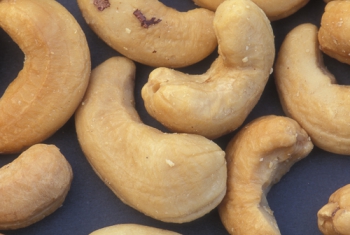 Evidence suggests
that consuming 60 grams of nuts daily may reduce fasting blood glucose and
glycosylated hemoglobin A1c (HbA1c).10 These attributes are crucial
to diabetes management and cardiovascular health. A recent meta-analysis of
clinical trials indicates that despite the high calorie and fat content of nuts,
long-term nut consumption is not associated with significant effects on body
weight when included in a healthy diet, and is in fact associated with a lower
risk of obesity.7,10 Possible mechanisms that may explain this
outcome include the thermogenic effects of readily oxidizable MUFAs and PUFAs,
incomplete nut mastication resulting in lost calories via stool elimination,
and enhanced satiety that results in less-frequent snacking.10 Evidence suggests
that consuming 60 grams of nuts daily may reduce fasting blood glucose and
glycosylated hemoglobin A1c (HbA1c).10 These attributes are crucial
to diabetes management and cardiovascular health. A recent meta-analysis of
clinical trials indicates that despite the high calorie and fat content of nuts,
long-term nut consumption is not associated with significant effects on body
weight when included in a healthy diet, and is in fact associated with a lower
risk of obesity.7,10 Possible mechanisms that may explain this
outcome include the thermogenic effects of readily oxidizable MUFAs and PUFAs,
incomplete nut mastication resulting in lost calories via stool elimination,
and enhanced satiety that results in less-frequent snacking.10
In a parallel-arm,
RCT study, adults with type 2 diabetes with low HDL as well as dyslipidemia
consumed their normal diet with or without 30 grams of raw cashews daily for 12
weeks.10 Those consuming the cashew nuts did so mid-morning or as an
evening snack, not as a cooking ingredient. No other type of nut was consumed.
Participants met with dietitians six times during the 12-week period to
complete diet recalls, including a single 24-hour recall at baseline for
participants in both groups. At the end of the study, those in the cashew group
had a significant reduction in systolic blood pressure compared to the those in
the control group. HDL levels were significantly improved from baseline, but there
were no significant reductions in LDL cholesterol or other blood lipid markers.10,11
Despite the significant increase in daily caloric intake by those in the cashew
group, participants did not experience an increase in weight, body mass index
(BMI), or waist circumference.
Consumer Considerations
Globally, cashews are
one of the most popular tree nuts7 and have clinically supported
cardiovascular benefits when added to typical American diet.9 Cashew
oil can be extracted from the seed and used for culinary purposes.3 Although
less frequent than tree nut allergies, cashews can cause allergic reactions in
some individuals.3
Epidemiological
evidence indicates that more than 170 foods can cause immunoglobulin E (IgE)-mediated
allergic reactions.8 Cashew proteins are associated with potent
allergic reactions. Anacardein is the main soluble protein in cashews (accounting
for 40-45% of the total soluble proteins in cashew nuts) and is believed to be
the main trigger for hypersensitivity reactions when consumed.7 Cashew
nuts can cause two distinct hypersensitivity reactions: contact dermatitis
(linked to cardol and anacardic acid present in CNSL) and IgE-mediated food
allergy. Reactions can range from atopic dermatitis to fatal systemic allergic
reactions.7 Approximately 20% of patients with type 1
hypersensitivity to cashew nut experience anaphylaxis.7 Reports
reveal that cashew nut allergy is most common in young children (< four
years old) and adult females.8
Consumers should be
aware that cashew nut powder is often added to chocolate (from Theobroma
cacao, Malvaceae) and milk-based products.7 Recent research
indicates that the powdered milk used in manufacturing milk chocolate powder
can contain approximately 25% roasted cashew kernel.8 Moreover,
cashew processing treatments such as autoclaving, blanching, frying, and
microwave heating have no effect on cashew nut allergens.8
Nutrient Profile12
Macronutrient Profile: (Per one ounce raw cashews)
157 calories
5 g protein
9 g carbohydrate
12 g fat
Micronutrient
Profile: (Per one ounce raw cashews)
Excellent source of:
Copper: 0.62 mg (41%
DV)
Zinc: 1.64 mg (20.5%
DV women; 15% DV men)
Manganese: 0.47 mg (20.4%
DV)
Very good source of:
Magnesium: 82.8 mg (19.7%
DV)
Phosphorus: 168 mg (13.4%
DV)
Iron: 1.89 mg (10.5% DV)
Selenium: 5.64 mcg
(10.3% DV)
Good source of:
Vitamin K: 9.67 mcg (8%
DV)
Vitamin B6:
0.12 mg (7% DV)
Also provides:
Potassium: 187 mg (4%
DV)
Dietary Fiber: 0.94 g
(3% DV)
Niacin: 0.30 mg (2%
DV)
Folate: 7.1 mcg (1.8%
DV)
Vitamin E: 0.25 mg (1.7%
DV)
Riboflavin: 0.02 mg
(1.5% DV)
Trace amounts:
Calcium: 10.5 mg
(0.8% DV)
Vitamin C: 0.14 mg (0.2%
DV)
Thiamin: 0.12 mg (0.1%
DV)
DV = Daily Value as
established by the US Food and Drug Administration, based on a 2,000-calorie
diet.
|
Recipe: Stir-Fried
Vegetables with Toasted Cashews
Courtesy of Food
and Wine13
Ingredients:
- 3 tablespoons vegetable or chicken broth
- 1 teaspoon cornstarch
- 3 tablespoons cooking oil
- 2/3 cup cashews
- 1 pound mushrooms, sliced thin
- 1/2 teaspoon salt
- 4 scallions, white bulbs sliced thin, green tops
chopped and reserved separately
- 3/4 teaspoon toasted sesame oil
- 3 cloves garlic, minced
- 1 quart broccoli florets (for more information on
the benefits of broccoli, click here14)
- 1 ½ quarts napa cabbage, shredded
- 1/4 teaspoon dried red pepper flakes
- 1 tablespoon oyster sauce
- 2 tablespoons soy sauce or tamari
Directions:
- In a small bowl, combine 1 tablespoon of broth with
the cornstarch and stir to make a slurry.
- In a wok or a large nonstick frying pan, heat 1/2
tablespoon of cooking oil over medium-high heat. Add cashews and cook until
starting to brown, 1-2 minutes. Transfer the nuts to a medium bowl.
- In the same pan, heat 1 tablespoon cooking oil over
medium-high heat. Add the mushrooms and 1/4 teaspoon salt and cook, stirring
occasionally, until golden brown, about five minutes. Transfer to the bowl
with the cashews.
- Add the scallion greens and sesame oil into the
bowl with mushrooms and cashews and stir to combine.
- Heat the remaining 1 ½ tablespoons cooking oil over
medium-high heat. Add the scallion whites and garlic and cook for 30 seconds,
until fragrant. Add the broccoli and cook for one minute. Next, add the
cabbage, cooking two minutes until cabbage wilts.
- Add the remaining 2 tablespoons broth and 1/4
teaspoon salt, red pepper flakes, and the oyster and soy sauces to the pan
and stir to combine.
- Stir the cornstarch slurry to recombine before
adding it to the pan. Coat the vegetables with the sauce and cook an
additional minute until slightly thickened. Top with the mushroom mixture.
- Serve with either white or brown rice.
|
Image Credits (top to bottom):
Anacardium occidentale. ©2020 Steven
Foster
First known illustration of a cashew tree by André Thevet. 1558.
Anacardium occidentale. ©2020 Steven
Foster
Anacardium occidentale. ©2020 Steven
Foster
Anacardium occidentale. ©2020 Steven
Foster
References
- Anacardiaceae.
Encyclopedia Britannica. Available at: www.britannica.com/plant/Anacardiaceae. Accessed on September 21, 2020.
- Cashew. Encyclopedia
Britannica. Available at: www.britannica.com/plant/cashew#ref194103.
Accessed on September 21, 2020.
- Cashew. New World
Encyclopedia. Available at: www.newworldencyclopedia.org/entry/Cashew. Accessed on September 21, 2020.
- National Geographic Society. Edible: An Illustrated Guide to the World’s
Food Plants. Lane Cove, Australia: Global Book Publishing; 2008.
- Morton J. Cashew
apple. Fruits of Warm Climates. Available at: www.hort.purdue.edu/newcrop/morton/cashew_apple.html. Accessed on September 22, 2020.
- Griffin L, Dean L.
Nutrient composition of raw, dry-roasted, and skin-on cashew nuts. Journal of Food Research.
2017;6(6)13-28.
- Kluczkovski A,
Martins M. Cashew nut. In: Caballero B, Finglas P, Toldra F, eds. Encyclopedia
of Food and Health. Manaus, Brazil: Federal University of Amazonus; 2016:683-686.
- Tufail T, Saeed F, Ain H, et al. Cashew nut allergy; immune health challenge. Trends in Food Science & Technology.
2019;86:209-216.
- Mah E, Schulz J, Kaden V, et al. Cashew consumption reduces total and LDL
cholesterol: A randomized, crossover, controlled-feeding trial. American Journal of Clinical Nutrition.
2017;105:1070-1078.
- Mohan V, Gayathri R, Jaacks L, et al. Cashew nut consumption increases HDL
cholesterol and reduces systolic blood pressure in Asian Indians with type 2 diabetes:
A 12-week randomized controlled trial. The Journal of Nutrition.
2018;148:63-69.
- Baer D, Novotny J.
Consumption of cashew nuts does not influence blood lipids or other markers of
cardiovascular disease in humans: A randomized controlled trial. American Journal of Clinical Nutrition.
2019;109:269-275.
- Cashew nut. USDA Food
Data Central. Available: https://fdc.nal.usda.gov/fdc-app.html#/food-details/170162/nutrients. Accessed
on October 2, 2020.
- Stir-fried vegetables
with toasted cashews. Food and Wine. September 2012. Available at: www.foodandwine.com/recipes/stir-fried-vegetables-toasted-cashews. Accessed on October 2, 2020.
- Bauman H, Darby S.
Food as Medicine: Broccoli (Brassica oleracea, Brassicaceae).
HerbalEGram. 2016;13(3). Available at: http://cms.herbalgram.org/heg/volume13/03March/FoodAsMedicine_Broccoli.html.
Accessed October 5, 2020.
|